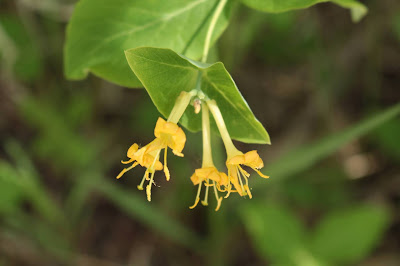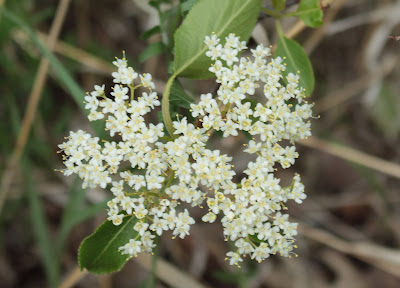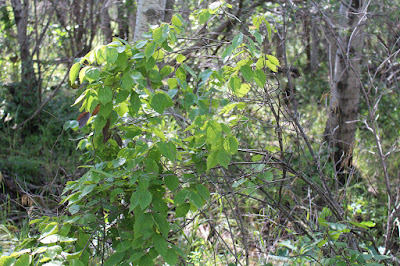Bold Italic
headings indicate species not listed on the Habitat Site Report.
Close-Up
The Habitat Site List identifies Apple as a species found in
the Assiniboine Forest in 2007. In fact, there are two
species present, both of which I would call Crabapple.
One has a larger fruit, tasty but tart, about 2.5 to 3 cm.
in diameter, and a very apple-like skin. The other has
small fruit, just over 1 cm. in diameter, more uniform in
colour, and resembling other small red red berries.
The above three photos show the larger variety of
crabapple, with fruits 2.5 to 3 cm. in diameter.
The above four photos show the smaller variety of crabapple, with fruits just over 1 cm in diameter.
Tartarian Honeysuckle flowers can be white (as above), pink (as shown below), or white with a pinkish accent.
Cherries
Red, Orange, or Brown Berries
High Bush Cranberry
Canada Plum
Crabapple (Mid-Sized)
Crabapple (Small)
Long-Spined Hawthorn
Tartarian Honeysuckle
Twining Honeysuckle
Nannyberry
Narrowleaf Meadowsweet
Canada Plum
Crabapple (Mid-Sized)
Crabapple (Small)
Long-Spined Hawthorn
Tartarian Honeysuckle
Twining Honeysuckle
Nannyberry
Narrowleaf Meadowsweet
Dark Blue-Violet Berries
White Berries
Roses
Aggregate Berries
Nuts and Other Seed Types
Conifers
Click on Images to Enlarge
Cherries
Chokecherry
Prunus virginianaNative, also known as Western Choke Cherry, Bitter Berry
Red, Orange, or Brown Berries
High Bush Cranberry
Viburnum opulus var. americanum OR Viburnum trilobum
Native, also known as American Cranberry, Guelder Rose, Dog Rowan, Water Elder, Cramp Bark, Snowball Tree
Perhaps the largest High-Bush Cranberry in the Assiniboine
Forest, this 10-foot shrub is a cluster of at least seven
branches emanating from a central point and spreading
outwards.
The striking white flowers are in a cluster, or corymb,
with a few sterile outer florets centered around many
smaller fertile florets.
Close-Up
The High Bush Cranberry is not a true Cranberry or even closely related, but gets its name from the drooping red fruit which look like cranberries,have a similar flavor and ripen at the same time of year..
Prunus nigra
Native, also known as Black Plum
Crabapple (Mid-Sized & Small)
Malus spp.
Unknown origin
The flowers of Crabapple, Plum, and Pin Cherry are
actually very similar.
The above four photos show the smaller variety of crabapple, with fruits just over 1 cm in diameter.
Native, also known as Fleshy Hawthorn, Succulent Hawthorn
There may be two varieties of Hawthorn in the
Assiniboine Forest, including the Long-Spined
variety. One seems to have larger leaves
than the other.
Lonicera tatarica
Introduced.
Tartarian Honeysuckle flowers can be white (as above), pink (as shown below), or white with a pinkish accent.
Dark Blue-Violet Berries
Saskatoon
Amelanchier alnifoliaNative, also known as Serviceberry, Western Serviceberry, Western Shadbush, Western Juneberry
Introduced, also known as European Buckthorn, Purging Buckthorn
Native, also known as Viburnum
Downy Arrowood is very distinctive in autumn because
of its intense colours, which range from a bright
crimson to a deep maroon. At this time of year,
its leaves are usually mottled with greens along the
vein lines, left over from the summer.
White Berries
Red Osier Dogwood
Cornus stolonifera
Native, also known as Red Osier, Red Brush, Red Willow, Redstem Dogwood, American Dogwood, Western Dogwood, Creek Dogwood
Native, also known as Waxberry, White Coralberry
Native, also known as Fly-Trap Dogbane
Being members of the same family, Spreading Dogbane and Indian Hemp (below) are quite similar and somewhat difficult to identify. The flowers and seedpods of the two plants resemble each other, but Spreading Dogbane is a shorter shrub.
Native, also known as Dogbane, Wild Cotton
Native, also known as Wild Rose, Prickly Wild Rose
The flowers and growth habit of Prickly Rose and Smooth Rose (below) are similar. The primary way to tell them apart is to look at the new growth - Prickly Rose has dense prickles on both old and new growth. New growth of Smooth Rose has no prickles.
Native, also known as Wild Rose, Meadow Rose, Prairie Rose
Native, also known as American Hazel
According to the Habitat Site Report, here are two species of Hazelnut in the Assiniboine Forest. The nuts of American Hazelnut come in a cluster, while those of Beaked Hazelnut are in a beak-shaped tube.
The fruit cluster are four nuts enclosed in leaflike
bracts.
Siberian Elm
Ulmus pumilaIntroduced, also known as Dwarf Elm, Asiatic Elm
Siberian Elm plants do not have soft fruit or nuts, but have winged seeds.
Close-Up
Conifers
Common Juniper
Juniperus communisNative to Canada
More
Unidentified & Unusual
This photo had me stumped for a while because of the
berries that resembled those of Red Osier Dogwood,
combined with serrated leaves (which Red Osier doesn't
have). Answer: it's Red Osier peeking out from
behind American Hazelnut.





























































































































